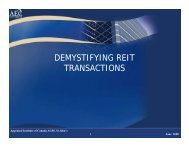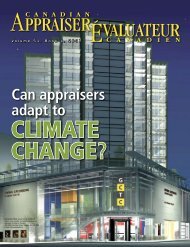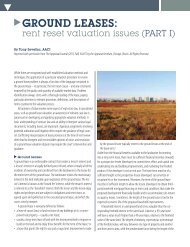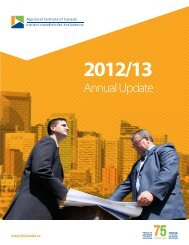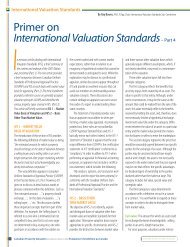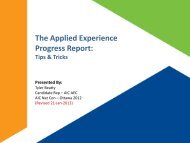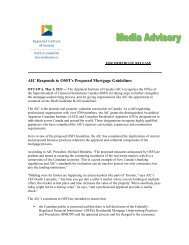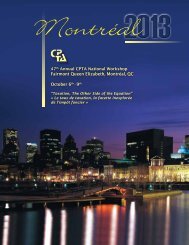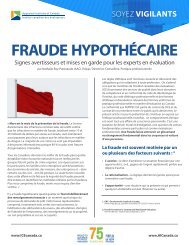How to successfully complete the applied experience written ...
How to successfully complete the applied experience written ...
How to successfully complete the applied experience written ...
Create successful ePaper yourself
Turn your PDF publications into a flip-book with our unique Google optimized e-Paper software.
Learning AdvisoryBy Duane Bates, AACI, P. App, Member, Learning Advisory CommitteeWrite once, write right<strong>How</strong> <strong>to</strong> <strong>successfully</strong> <strong>complete</strong><strong>the</strong> <strong>applied</strong> <strong>experience</strong> <strong>written</strong>examinationGetting <strong>to</strong> <strong>the</strong> stage of writing <strong>the</strong><strong>applied</strong> <strong>experience</strong> exam requiresexceptional time and hard work. Assuch, Candidates should not take this exam lightlyand must ensure <strong>the</strong>y are appropriately preparedfor this challenge. This article details <strong>the</strong> steps thatCandidates should consider <strong>to</strong> confidently andcompetently promote successful achievement.What is being examined?Before you start preparing, think about what isbeing asked of you throughout this exam. It is youropportunity <strong>to</strong> show <strong>the</strong> marker that you haveacquired sufficient <strong>experience</strong>s and competenciesthrough guided men<strong>to</strong>rship, such that you canapply <strong>the</strong> First Principles of Value appropriately in agiven situation.This exam is not one you can study for froma text book. Therefore, before you apply <strong>to</strong> writethis exam, ask yourself whe<strong>the</strong>r or not you haveattained sufficient <strong>experience</strong> <strong>to</strong> <strong>successfully</strong> writeit. Ask your men<strong>to</strong>r for an honest opinion, becauseit is better that you gain more <strong>experience</strong> first thanlearn of this need through failure.<strong>How</strong> <strong>to</strong> prepare for <strong>the</strong> examAIC has prepared several online <strong>to</strong>ols <strong>to</strong> helpCandidates prepare for <strong>the</strong> <strong>applied</strong> <strong>experience</strong>examination:• The Revised Edition of First Principles of Value• Sample CRA and AACI Applied Experience Exam• Sample Grading Sheet and Marking Criteria• Tips for Writing <strong>the</strong> Examination• Exam Writing StrategiesThe AIC Applied Experience Written Examinationweb site can be found at: http://www.aicanada.ca/cmsPage.aspx?id=164The UBC Real Estate Division’s web site alsosummarizes <strong>the</strong>se resources at: www.realestate.ubc.ca/aeexamYou cannot study for this exam as you wouldfor a regular course exam, but you can prepare.Review <strong>the</strong> First Principles of Value very closely,and be prepared <strong>to</strong> speak <strong>to</strong> each with reference <strong>to</strong>your own value-related <strong>experience</strong>s. Refer <strong>to</strong> <strong>the</strong>sample exam questions so that you know what<strong>to</strong> expect, and read <strong>the</strong> sample exam in advanceso that you do not have <strong>to</strong> read <strong>the</strong> instructionsduring <strong>the</strong> exam time. Think of good examplesfrom your work <strong>experience</strong> that highlight challengingproblems related <strong>to</strong> one or more First Principles,and structure answers that discuss <strong>the</strong>m – thiswill help you become familiar with <strong>the</strong> logic andstyle of answer required, and you may be able <strong>to</strong>use <strong>the</strong>se examples on your exam. Ensure that youknow <strong>the</strong> address or can adequately describe <strong>the</strong>locations of <strong>the</strong>se examples.<strong>How</strong> <strong>to</strong> write <strong>the</strong> examefficiently and effectivelyYou have talked <strong>to</strong> your men<strong>to</strong>r, you have sufficient<strong>experience</strong> required <strong>to</strong> tackle <strong>the</strong> exam,you have reviewed <strong>the</strong> First Principles of Value,you went through <strong>the</strong> sample exam so youknow what kind of questions <strong>to</strong> expect, and,most importantly, you looked at <strong>the</strong> gradingsheet and criteria for <strong>the</strong> allocation of marks.Now what?Have a mental plan in place for how you willapproach <strong>the</strong> exam. Some points <strong>to</strong> keep in mind:• Equate marks with time available and wordsrequired: The exam is three hours – allot yourtime accordingly. You have one case study andthree work <strong>experience</strong> questions <strong>to</strong> answer. Youhave read <strong>the</strong> marking guide, so you know how<strong>the</strong> grading is weighted – if you have a 40-markquestion, you should be allotting roughly 72minutes for that portion of your exam. If youfinish after an hour of writing, you may want <strong>to</strong>review your answers <strong>to</strong> ensure <strong>the</strong>re is enoughcontent <strong>to</strong> justify <strong>the</strong> 100 marks. Ensure yourwork <strong>experience</strong> examples give enough detailfor <strong>the</strong> marker <strong>to</strong> identify <strong>the</strong> specific propertyand understand <strong>the</strong> scenario being described.• Get easy marks first: Answer first <strong>the</strong> questionsthat you find <strong>the</strong> easiest. This will help yourconfidence, calm you down, and may even giveyou extra time <strong>to</strong> tackle <strong>the</strong> more challengingquestions later on in <strong>the</strong> exam.• No marks if we cannot read it: write legibly! Werealize it is three hours of writing, but you mustensure that you write legibly and preferably witha pen (leave <strong>the</strong> pencils at home; you can crossthings out and use additional exam booklets ifneeded). Remember, if <strong>the</strong> marker cannot readyour writing, <strong>the</strong> chances of receiving a successfulgrade are reduced dramatically.• Answer <strong>the</strong> question – no more, no less: Readeach question fully. You will receive no marks foranswers <strong>to</strong> questions that are not being asked.This cannot be stressed enough … READ THEQUESTION.• Paint a picture, not a sketch: When asked <strong>to</strong>describe a property, do not be vague in youranswer. For example, “A house with a basement30Canadian Property Valuation Volume 53 | book 4 | 2009 Évaluation Immobilière au Canada
on a quiet street,” will get you zero marks. Amore appropriate response would be, “A 1,200square foot 1970s bungalow, with full-finishedbasement, located at <strong>the</strong> NW corner of Mainand Fraser Streets, Woodpile, Saskatchewan.Neighbouring and adjacent properties are similarin age in utility. Middle and high school arewithin walking distance, transit is available on<strong>the</strong> corner, neighbourhood strip mall with 12units one block away. Neighbourhood is stableand considered <strong>to</strong> have average demand. Pricinglevels have been stable for <strong>the</strong> last year due <strong>to</strong>stable local economic conditions.”You have <strong>to</strong> paint a picture for <strong>the</strong> marker, realizingthat we likely come from a different part of Canadathan you. For property location, if you cannotremember <strong>the</strong> address, <strong>the</strong>n give a description –<strong>the</strong> marker must be able <strong>to</strong> tell that it is real, not ahypo<strong>the</strong>tical example.• Explain your assumptions: Assumptions areacceptable and expected when answering <strong>the</strong>case study portion of <strong>the</strong> exam, as long as <strong>the</strong>yare reasonable and kept in perspective of <strong>the</strong>situation being addressed. If <strong>the</strong> case studyindicates <strong>the</strong>re has been no market activity in<strong>the</strong> area, do not respond by assuming that youhave adequate sales in <strong>the</strong> area <strong>to</strong> support anestimate of market value. Assumptions shouldnot be used as a crutch <strong>to</strong> easily get through<strong>the</strong> case study; this will return a failing grade.For example, saying, “Highest and best useis assumed <strong>to</strong> be <strong>the</strong> current use” withoutexplanation equals zero marks. You must explain<strong>to</strong> <strong>the</strong> marker <strong>the</strong> steps you would take <strong>to</strong> arriveat that conclusion.• Give answers, not questions: Do not answer <strong>the</strong>case study question with more questions, thiswill likely result in a failing grade. Asking a stringof erroneous questions does not demonstrate<strong>to</strong> <strong>the</strong> marker that you have logically thoughtthrough <strong>the</strong> First Principles of Value <strong>to</strong> arrive at aconclusion for <strong>the</strong> situation presented.• Appropriate work examples: Your work <strong>experience</strong>examples should be appropriate for yourlevel of <strong>experience</strong>. If you are writing <strong>the</strong> CRAexam, <strong>the</strong>n avoid work examples of propertiesthat do not conform <strong>to</strong> <strong>the</strong> CRA limitations. As aCRA Candidate, if you discuss properties beyond<strong>the</strong> CRA’s limitations, <strong>the</strong>n be cautious <strong>to</strong> explain<strong>the</strong> limitations of your role and where additionalassistance was required. O<strong>the</strong>rwise, it is a breachof professional ethics.• Cautious terminology: Avoid slang terms, acronyms,and improper terminology. For example:- In Canada, we use CUSPAP, not USPAP;- If you are describing a retrospective report, donot call it a retroactive report;- AIC uses market value, not fair market value(an accounting term);Avoid using acronyms in your examples, asmarkers are from various regions of Canada andmay be unfamiliar with <strong>the</strong> terms, e.g., AccreditedMunicipal Assessor of Alberta (AMAA),Property Assessment Appeal Board (PAAB), etc.• Answer everything: Try and get an answer downfor all questions. If you miss answering one of <strong>the</strong>work <strong>experience</strong> examples due <strong>to</strong> lack of time,it leaves little margin for error <strong>to</strong> pass <strong>the</strong> exam,given <strong>the</strong> minimum <strong>to</strong>tal pass mark of 70%needed on both case study and work <strong>experience</strong>.• Be general and comprehensive: When answering<strong>the</strong> case study portion of <strong>the</strong> exam, avoidanswering it solely from <strong>the</strong> specialized or limitedperspective of your current job. Explaining<strong>to</strong> <strong>the</strong> marker that you need not be concernedwith market value because of assessment lawin your province will undoubtedly not cover allFirst Principles of Value. Answer <strong>the</strong> questionfrom a wider, more general, and morecomprehensive perspective.• Consider Point Form: To best answer <strong>the</strong> casestudy, you must work through all of <strong>the</strong> FirstPrinciples of Value. Using expanded point form<strong>to</strong> go through each principle can be an efficientand effective way of ensuring you are coveringall aspects of <strong>the</strong> case study.• ‘I’ not ‘we’: Be careful about <strong>the</strong> ‘team’approach – when answering <strong>the</strong> work<strong>experience</strong> example questions, explain <strong>to</strong><strong>the</strong> marker what ‘you’ did, not what ‘we’did. This does not preclude teamwork, butyou must tell what you did in that team <strong>to</strong>address <strong>the</strong> First Principle being described.• Explain suitability: There are three parts <strong>to</strong> <strong>the</strong>work <strong>experience</strong> question: description, suitabilityand details. The second part is easily overlooked,but, if answered appropriately, it segues nicelyin<strong>to</strong> <strong>the</strong> details of <strong>the</strong> example.Answer <strong>the</strong> 5 W’s and do not forget <strong>the</strong> HFinally, keep in mind <strong>the</strong>se last few importantpoints for success:• Answer <strong>the</strong> who, what, when, where, why, anddo not forget <strong>the</strong> how. At <strong>the</strong> end of <strong>the</strong> day, <strong>the</strong>how is what <strong>the</strong> marker is looking for. <strong>How</strong> didyou determine highest and best use, how didyou find market evidence <strong>to</strong> justify <strong>the</strong> adjustmentmade, how did you analyze <strong>the</strong> economicvariables of <strong>the</strong> situation, how did you ensurethat you reviewed all possible legal issues thatcould have an effect on your estimate of marketvalue, how did you ensure <strong>the</strong> property rightswere those of <strong>the</strong> fee simple….and so on.• Make it easy for <strong>the</strong> marker <strong>to</strong> logically gothrough your exam and understand how youhave related everything back <strong>to</strong> <strong>the</strong> First Principlesof Value. Keep <strong>the</strong> verbosity in check. Forexample, “It is assumed that <strong>the</strong> property rightsappraised are those of <strong>the</strong> fee simple interest.”Do not go in<strong>to</strong> an elaborate dissertation on <strong>the</strong>concept of <strong>the</strong> Bundle of Rights if unnecessary.• Last, but not least, remember you are puttingforward a professional argument for review andexamination. Do not assume <strong>the</strong> marker knowswhat you are trying <strong>to</strong> say, tell <strong>the</strong> marker whatyou are saying. Logic of argument, compositionof material and rationale behind assumptionsall play a fac<strong>to</strong>r. Writing clearly, logically, andthoroughly without being long-winded andrepetitious will serve you well in presenting awell-<strong>written</strong> exam.Learning Advisory CommitteeDavid Highfield, AACI, P. App – ChairApril Green, CandidateSuzanne de Jong, AACI, P. AppWayne Kipp, AACI, P. AppVikki Leslie, Qualifications Officer, AIC - ONCharles Abromaitis, AACI, P. AppDuane Bates, AACI, P. AppDavid Shum, AACI, P. AppTo contact this committee email:lac@aicanada.caCanadian Property Valuation Volume 53 | book 4 | 2009 Évaluation Immobilière au Canada 31



